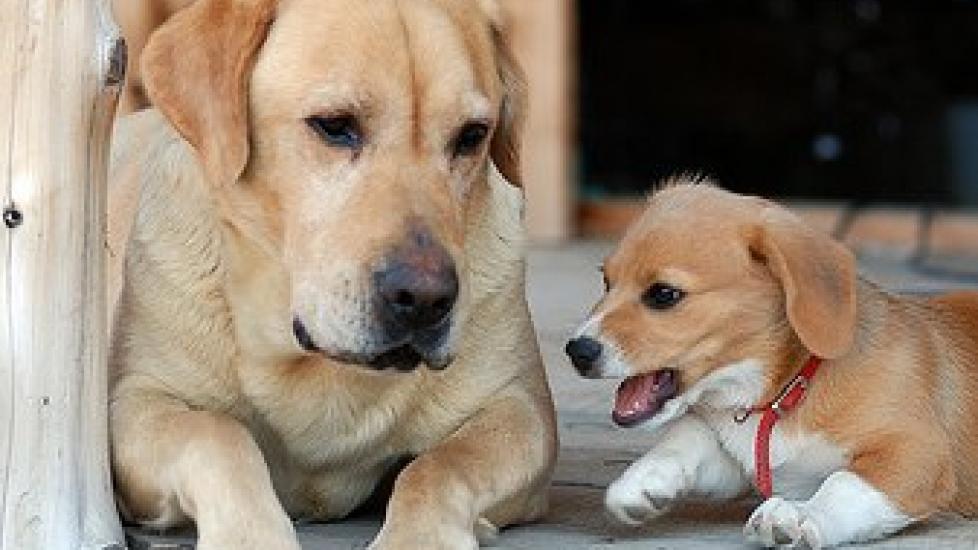What’s a BDLD (Big-Dog-Little-Dog)? ... And Why You Should Care
Got a small dog? A big dog? Chances are you have one or the other. Either way, you should know of a pet healthcare scenario we call BDLD (big-dog-little-dog). It’s what happens when big dogs take a chomp out of little ones, battering and bruising them to within an inch of their lives — if not outright killing them.
All it takes is one bite, a halfway energetic shake of the head, and the next thing you know the little dog’s on the floor in need of the speediest trip to the vet he’s ever been treated to. No, it’s never pretty.
Sometimes it happens when the little dogs act inappropriately. Indeed, more often than not that’s at least part-way the case. Small dogs in our culture are often allowed to act like little Napoleons, and are consequently capable of putting themselves in harm’s way more effectively than any wild dog might in a standard pack scenario (after all, they’ve been raised to believe the world revolves around their familial nexus; i.e., them).
Other times it’s all about the big ‘uns. They’re unsocialized and unruly. Maybe they have predatory aggression issues that would preclude their inclusion in any social scenario (think puppy parks) — if only their owners recognized and responded to the warning signs.
But mostly, it’s a perfect storm of all of the above issues. Perhaps there’s a toy involved. Or a treat. Or an accidental snarl or snort. Or some other trigger. Just add water … and an insta-disaster ensues.
In the aftermath of the blowup, the most common injuries have to do with “simple” crushing of tissues. A set of jaws applied with medium pressure to the chest or abdomen is usually enough to cause bleeding, bruising, muscle separation and herniation (as when cavities are breached and stuff that should remain in the abdominal or chest cavities spill into nearby locations — usually just under the skin).
Even if the little dog survives an acute, heavy-duty trauma like lung bruising (pulmonary contusions), bladder rupture, or abdominal herniation, the medium-term issues associated with infection can be impressively daunting. Imagine surviving serious injury only to suffer weeks or months of infections related to the original assault. Indeed, it’s for this reason I caution owners to accept the injuries at more than face value — a realistic, long-term outlook is absolutely necessary.
Largely, that’s because expenses can get impressive after weeks of intensive wound care. Recurrent cultures, daily bandage changes, expensive injectable antibiotics, hot packing, hydrotherapy, frequent surgeries, etc. It’s all part of the game — one I don’t wish upon anyone, much less an unsuspecting dog.
But it’s not the little dogs alone that suffer. Regardless of the circumstances, these bigger dog aggressors often get branded as dangerous, sometimes unfairly, sometimes with serious legal consequences. And owners are often left shouldering the little dogs’ whopping vet bills — along with the not-so-paltry guilt.
So here’s where I urge you not only to consider the serious suffering, high stress and significant expenses associated with BDLD situations. Here’s where I explain how an ounce of prevention … you know the rest.
Though 100 percent safety is impossible to achieve if you’re willing to let your dog socialize with others (something we'd all agree is almost always a good thing), there are some approaches that’ll help minimize the dangers associated with the worst kind of attacks. Though trainers and behaviorists are best equipped to opine, here are my trio of suggestions:
1. Socialization, socialization, socialization. It mirrors real estate’s famous refrain because it’s so crucial and so true: There’s nothing like taking steps early and often to ensure your dogs are well socialized with the widest possible variety of dogs and humans.
2. Training helps but often isn’t enough. We’re talking about instinctual behavior here. Little dogs can look like prey. Even the best-trained dog won’t necessarily respond to a command that goes against what every fiber of his doggy being is telling him is a perfectly acceptable solution to this fleeing thing in front of him. And can you blame him when most newfangled little dogs look more like large rodents than tiny dogs? (Come to Miami, I’ll show you the ones I mean.)
3. Know thine own dog. No dog is perfect. None of us is so delusional we’d fail to grasp this basic concept. Hence, I know that my bossy French bulldog with a respiratory tract that makes him sound like he’s constantly emitting a low growl would make a nice target for a bigger adversary. So why would I ever chance a romp at the puppy park when a big alpha dog is around? Sorry, it’s just not worth it.
Conversely, those who are in denial about their big dog’s designs on small things, whose triggers are poorly understood, or whose tolerance of little ones has never been put to the test … they should know that the “he never did that before” line is no excuse — especially when said big dog gets out for a multi-dog romp only once every other blue moon.
OK, so that’s enough testiness for today. Your turn...

Art of the day: "Big Dog, Little Dog" by J. Cator. Ace (big dog) and Max (little dog) play on the porch. Max looks like he wants it handed to him, right?

